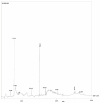Preliminary Screening on Antibacterial Crude Secondary Metabolites Extracted from Bacterial Symbionts and Identification of Functional Bioactive Compounds by FTIR, HPLC and Gas Chromatography-Mass Spectrometry
- PMID: 38930979
- PMCID: PMC11206551
- DOI: 10.3390/molecules29122914
Preliminary Screening on Antibacterial Crude Secondary Metabolites Extracted from Bacterial Symbionts and Identification of Functional Bioactive Compounds by FTIR, HPLC and Gas Chromatography-Mass Spectrometry
Abstract
Secondary metabolites, bioactive compounds produced by living organisms, can unveil symbiotic relationships in nature. In this study, soilborne entomopathogenic nematodes associated with symbiotic bacteria (Xenorhabdus stockiae and Photorhabdus luminescens) were extracted from solvent supernatant containing secondary metabolites, demonstrating significant inhibitory effects against E. coli, S. aureus, B. subtilus, P. mirabilis, E. faecalis, and P. stutzeri. The characterization of these secondary metabolites by Fourier transforms infrared spectroscopy revealed amine groups of proteins, hydroxyl and carboxyl groups of polyphenols, hydroxyl groups of polysaccharides, and carboxyl groups of organic acids. Furthermore, the obtained crude extracts were analyzed by high-performance liquid chromatography for the basic identification of potential bioactive peptides. Gas chromatography-mass spectrometry analysis of ethyl acetate extracts from Xenorhabdus stockiae identified major compounds including nonanoic acid derivatives, proline, paromycin, octodecanal derivatives, trioxa-5-aza-1-silabicyclo, 4-octadecenal, methyl ester, oleic acid, and 1,2-benzenedicarboxylicacid. Additional extraction from Photorhabdus luminescens yielded functional compounds such as indole-3-acetic acid, phthalic acid, 1-tetradecanol, nemorosonol, 1-eicosanol, and unsaturated fatty acids. These findings support the potential development of novel natural antimicrobial agents for future pathogen suppression.
Keywords: GC–MS; HPLC; PCR; antibacterial activity; entomopathogenic nematodes; symbiotic bacteria.
Conflict of interest statement
The authors declare no conflicts of interest. The funders had no role in the design of the study; in the collection, analyses, or interpretation of data; in the writing of the manuscript; or in the decision to publish the results.
Figures










Similar articles
-
A study on Xenorhabdus and Photorhabdus isolates from Northeastern Thailand: Identification, antibacterial activity, and association with entomopathogenic nematode hosts.PLoS One. 2021 Aug 12;16(8):e0255943. doi: 10.1371/journal.pone.0255943. eCollection 2021. PLoS One. 2021. PMID: 34383819 Free PMC article.
-
Antibacterial activity of Xenorhabdus and Photorhabdus isolated from entomopathogenic nematodes against antibiotic-resistant bacteria.PLoS One. 2020 Jun 5;15(6):e0234129. doi: 10.1371/journal.pone.0234129. eCollection 2020. PLoS One. 2020. PMID: 32502188 Free PMC article.
-
Isolation and identification of Xenorhabdus and Photorhabdus bacteria associated with entomopathogenic nematodes and their larvicidal activity against Aedes aegypti.Parasit Vectors. 2017 Sep 21;10(1):440. doi: 10.1186/s13071-017-2383-2. Parasit Vectors. 2017. PMID: 28934970 Free PMC article.
-
Symbiotic Bacteria as Potential Agents for Mosquito Control.Trends Parasitol. 2020 Jan;36(1):4-7. doi: 10.1016/j.pt.2019.07.003. Epub 2019 Jul 30. Trends Parasitol. 2020. PMID: 31375436 Review.
-
Does the Future of Antibiotics Lie in Secondary Metabolites Produced by Xenorhabdus spp.? A Review.Probiotics Antimicrob Proteins. 2020 Dec;12(4):1310-1320. doi: 10.1007/s12602-020-09688-x. Probiotics Antimicrob Proteins. 2020. PMID: 32844362 Review.
References
-
- Gobinath C., Rodríguez-Hernández A.I., del Rocío López-Cuellar M., Palma-Rodríguez H.M., Chavarría-Hernández N. Bacteriocin encapsulation for food and pharmaceutical applications: Advances in the past 20 years. Biotechnol. Lett. 2019;41:453–469. - PubMed
-
- Shi Y.M., Hirschmann M., Shi Y.N., Ahmed S., Abebew D., Tobias N.J., Grün P., Crames J.J., Pöschel L., Kuttenlochner W., et al. Global analysis of biosynthetic gene clusters reveals conserved and unique natural products in entomopathogenic nematode-symbiotic bacteria. Nat. Chem. 2022;14:701–712. doi: 10.1038/s41557-022-00923-2. - DOI - PMC - PubMed
MeSH terms
Substances
Grants and funding
LinkOut - more resources
Full Text Sources
Medical
Miscellaneous

